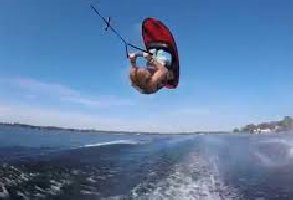Kneeboarding History
Details:
Kneeboarding's History
A popular alternative to three-event water skiing, wakeboarding and barefooting is kneeboarding. Along with a pair of combo skis, you'll find a kneeboard in most recreational boats. However, the sport also has a competitive following.
Kneeboard athletes compete in slalom, tricks and expression session events. In slalom, the six buoys are positioned the same as a traditional course. Tricks are performed in two 20-second passes and awarded technical and subjective points. A kneeboard expression session is similar to a wakeboard event, each pass is scored subjectively for style points.
The roots of modern kneeboarding can be traced to Southern California, where surfboard enthusiasts tried using their homemade "knee" and "belly" boards behind boats about 35 years ago.
Surfers in other parts of the country soon caught on to the new concept of "surf-skiing." As early as 1965, the Inland Wake Board was developed in Downey, Calif., and was being sold through Abercrombie & Fitch stores in the East, South and West.
During the late 1960s and early 1970s, several California entrepreneurs were working on a kneeboard specifically designed for towing behind a boat. Mike Murphy worked with Bud Holtz to produce the fiberglass-wrapped Knee Ski, while John Taylor invented the blow-molded plastic Glide Slide. Of the two, the Glide Slide enjoyed the greatest, though short-lived, commercial success.
A skier named Danny Churchill, who had worked for Taylor, soon got financial backing to form the Portugal Company and bought Glide Slide out of bankruptcy.Churchill reshaped the board, switched to rotational molding and called the product Hydroslide. The company was bought by Kransco in 1982. Numerous water-ski manufacturers also began producing kneeboards; according to Churchill, a million have been sold since the products first hit the shelves.
The first kneeboards were much heavier and more cumbersome than the boards used today. They resembled large teardrops, with flat bottoms, thin knee straps and slippery rubber knee pads. Today, the shape has changed. The bottom is contoured to provide better performance, the knee strap is broad and helps to hold the skier on the board, and the pads are resilient to protect the skier’s knees from injury.
Kneeboards are now manufactured by many of the nation’s top water-ski producers and they come in a variety of colors, shapes and sizes. There are boards for novice skiers, as well as more sophisticated ones for experienced skiers.
Kneeboarding as a competitive activity is a relatively new sport, having developed with in the past 17 years. In 1983, a group of traditional waterskiers from the lower Midwest banded together to form a club that would encourage kneeboarding as a competitive sport. They chartered the American Kneeboard Association (AKA), and produced slalom and tricks events that were modeled closely after events sanctioned by USA Water Ski. Two other events,wake crossings and turns, were tried but have since become "novice only" events.
As news of competitive kneeboarding spread, interest in the sport grew tremendously. Today, there are thousands of recreational and competitive kneeboard skiers across the world.
Many changes have occurred since the AKA was formed in 1983. The association is now recognized internationally as the leading authority on competitive kneeboarding. It is governed by an elected board of volunteer directors, who meets regularly throughout the year to discuss tournaments, new tricks and rule changes. In January 1988, the AKA achieved Sport Division status with USA WaterSki, the national governing body for the sport of water skiing.
more information about this product


 Click Image to Enlarge
Click Image to Enlarge
View Video Galleries
Helpful information for the boaters; tips and entertainment collection.
View Photo Galleries
A collection of photo galleries related to
ski-racing, fishing and water sports.
Share with